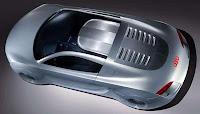Audi Q7, 2006




When it was first rolled out three years ago, the Audi Q7 performance SUV immediately achieved a leadership position - as a sporty, comfortable as well as high-performance recreational and business vehicle on a grand scale. Now Audi is making it even better - more elegant and more efficient, with lower emissions: the Audi Q7 3.0 TDI consumes only 9.1 liters per 100 kilometers (25.85 US mpg). And now it's also available in a new version as a TDI clean diesel, with the world's cleanest diesel technology and even lower fuel consumption of only 8.9 liters/100 km (26.43 US mpg).
The design: The language of dynamics
At the front end, the large single-frame radiator grille has been redesigned. Vertical chrome bars contrast with its black high-gloss finish. The bumpers too have been restyled. Their lower section is now painted in a contrasting black or gray, depending on the body color. The newly integrated underbody protection in the center section of the bumper has a distinctive ribbed design.
As alternatives to the standard halogen headlights, Audi offers a xenon plus variant and a new adaptive-light system that integrates not only low-beam, high-beam and a special superhighway beam but also turning and cornering lights. In conjunction with the xenon headlights, light-emitting diodes assembled to form U-shaped bands provide the daytime running lights. The front blinkers are also composed of LEDs as straight-line arrays, located at the upper edge of the air intakes.
The side view too, with its coupe-like roofline, low window area and tautly curved body surfaces, reinforces the dynamic look of the Audi Q7. Door moldings have been modified to add interest. The lightweight alloy wheels are size 7.5 J x 18, the wheels size 235/60. In the V6 vehicles they have seven spokes, in the V8 versions they have six.
At the rear end, the bumper has also been given two-tone paintwork; the tailgate, which includes a portion of the rear pillars in an S-shaped contour, has been given a new and distinctively 3D shape in the vicinity of the license plate bracket. To reduce the weight of the Audi Q7, the tailgate has been made of aluminum, as have the engine hood and the fenders. Standard LEDs in the tail lights create a distinctive lighting pattern.
The interior: Room to spare
Thanks to its luxurious 300-centimeter (118.11-inch) wheelbase within an overall length of 5.09 meters (16.70 feet), the Audi Q7 has interior room to spare, and the interior flexibility is unrivalled. The seatbacks in the second row are divided into three fold-down sections to provide a level cargo floor.
A multitude of detailed improvements in the interior enhance the elegance and the sense of well-being. The instrument cluster has been redesigned: the large, round, easily readable instruments are encircled by metallic frames. Interior lights in the door linings and an inlay on the passenger side enhance the interior styling. Many details of the control elements have been restyled and also enhanced by chrome elements.
The selection of interior colors and materials is also new. Upholstery fabrics are available in black and light gray; leather upholstery additionally also in Para Brown, Savannah Beige and Cardamon Beige. Standard inlays are finished in matt black. In optional design packages, aluminum and wood finishes are used.
The power train: Performance and efficiency
The Audi Q7 is available with six powerful and highly efficient direct injection engines, two of them gasoline-powered and four diesel engines, including the world's most powerful diesel SUV, the Audi Q7 V12 TDI. Their power is transmitted via a convenient and fast-shifting six-speed tiptronic to the quattro permanent all-wheel drive, which distributes it between the axles with slightly more than half to the rear.
The 3.0 TDI puts out 176 kW (240 bhp) and delivers as much as 550 Nm between 2,000 and 2,250 rpm, yet on the EU cycle it consumes only 9.1 liters / 100 km (25.85 US mpg). The optionally available 3.0 TDI clean diesel even consumes 0.2 liters (0.05 US gallons) less.
Despite highly complex exhaust gas recirculation and the resulting world's cleanest diesel technology, it consumes just 8.9 liters/100 km (26.43 US mpg). It meets the strict LEV II Bin 5 US standard and already complies with the Euro 6 limits announced for 2014.
The technology of the TDI clean diesel is highly complex. An advanced version of the common rail injection system with 2,000 bars of pressure, new combustion chamber sensors and a high-performance exhaust recirculating system ensure a highly efficient combustion process. An innovative DeNOx catalytic converter reduces the remaining nitrogen oxides. Just upstream of it, a pump injects an additive named AdBlue into the hot exhaust flow, where this solution decomposes into ammonia, which splits the nitrogen oxides into harmless nitrogen and water. Audi partners replenish the additive during regular maintenance servicing.
In the Q7 4.2 TDI too, fuel consumption has been drastically reduced - from 11.1 (21.19 US mpg) to 9.9 liters per 100 km (23.76 US mpg). Yet the V8 diesel is more powerful: with an output of 250 kW (340 bhp) and a torque of 760 Nm, it develops enormous propulsive power. This maximum torque is available in the range from 1,750 to 3,000 rpm.
The chassis: Safe and sporty
In its suspension technology too the Audi Q7 is exceptional. As a customer option, Audi equips the Q7 with adaptive air suspension - a pneumatic suspension system that operates in conjunction with an electronic shock absorber control, varies the ground clearance at five different levels, and lets the driver select three driving modes: comfort, automatic and dynamic. In its road handling the Audi Q7 excels in its sporty, highly responsive precision. Off-road, it provides a superior ride on widely varying terrains.



















 2011 Mitsubishi Outlander Sport
2011 Mitsubishi Outlander Sport 2011 Mitsubishi Outlander Sport
2011 Mitsubishi Outlander Sport
















